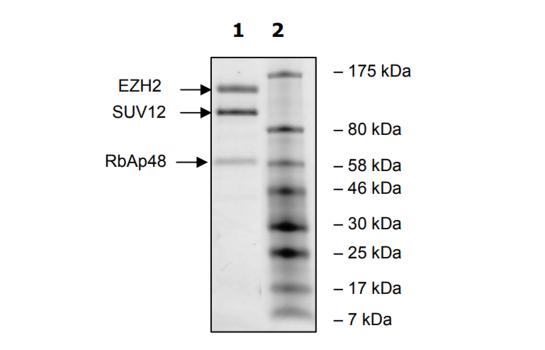EZH2/SUZ12/RbAp48, His-GST-tags, His-tag Recombinant
Catalog #
51098
$465
*
●
●
Purchase
Description
Complex of human EZH2 (GenBank Accession No. NM_004456), a.a. 2-end with N-terminal His-GST-tag, MW= 114 kDa, human SUZ12 (NM_015355), a.a. 1-end with N-terminal His-tag, MW = 87 kDa, and human RbAp48 (NM_005610), a.a. 2-end with N-terminal His-tag, MW= 48 kDa. Co-expressed in a baculovirus expression system.
●
Synonyms
KTM6, KTM6A, EZH2, PRC2, Enhancer Of Zeste Homolog 2; SUZ12, Suppressor Of Zeste 12 Homolog, CHET9, JJAZ1; RBAP48, Retinoblastoma Binding Protein 4 (RBBP4), NURF55, Chromatin Assembly Factor 1 Subunit C, CAF1 p48, EZH
●
Product Data Gallery
Product Info
Storage and Usage
Citations
Species
Human
Host Species/Expression System
Sf9 insect cells
Purity
≥80%
Format
Aqueous buffer solution
Formulation
40 mM Tris-HCl, pH 8.0, 110 mM NaCl, 2.2 mM KCl, 16 mM glutathione, 3mM DTT, and 20% glycerol.
MW
249 kDa (complex)
Amino Acids
2–end (EZH2, RbAp48), 1–end (SUZ12)
Genbank #
NM_004456 (EZH2), NM_015355 (SUZ12), NM_005610 (RbAP48)
UniProt #
Q15910
Background
EZH2 is the catalytic subunit of the PRC2/EED-EZH2 complex, which methylates Lys9 (H3K9me) and Lys27 (H3K27me) of histone H3, leading to transcriptional repression of the affected target gene. Able to mono-, di- and trimethylate Lys27 of histone H3 to form H3K27me1, H3K27me2 and H3K27me3, respectively. Compared to EZH2-containing complexes, it is more abundant in embryonic stem cells and plays a major role in forming H3K27me3, which is required for embryonic stem cell identity and proper differentiation. The PRC2/EED-EZH2 complex may also serve as a recruiting platform for DNA methyltransferases, thereby linking two epigenetic repression systems. Genes repressed by the PRC2/EED-EZH2 complex include HOXC8, HOXA9, MYT1, CDKN2A and retinoic acid target genes. EZH2 can also methylate non-histone proteins such as the transcription factor GATA4.
References
1. Varambally, S. et al. Science 322 (5908), 1695-1699 (2008).
2. Rakotobe, D. et al., Virol. J. 5, 32 (2008).
2. Rakotobe, D. et al., Virol. J. 5, 32 (2008).


